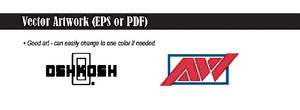Why Are They Telling Me My Artwork Won't Work?
One of the most frustrating phone calls that a distributor can receive is when the supplier cannot work with their customer’s artwork. For many distributors, who often do not have their own art department, trying to wade through art terminology is akin to understanding a foreign language. But not to worry! In this post, we are going to go over artwork basics to help alleviate that confusion.
Generally speaking, there are two types of artwork – vector and raster. Vector artwork is typically created by programs like Adobe Illustrator and CorelDraw and can be easily scaled without producing rough, “stair-step” edges like you will see if you enlarge a photograph too much. This means that the graphic designer working on your project can make the logo or image large or smaller without losing edge definition or causing blurriness. Vector files are typically saved as .EPS or .PDF files.
Raster artwork, on the other hand, is not easily scaled without losing edge definition which causes blurring and the “stair-step” edges we discussed above. Photographs, .JPG images and .TIF images are examples of raster artwork. There are times when suppliers can work with raster artwork, but only if they are saved as large resolution files (at least 300 dpi). These types of files are usually saved as .JPG or .TIF files.
So the big question is, can you convert a piece of raster artwork into a vector? The answer is sometimes… If the raster artwork is simple, one color, and saved in a high enough resolution, a graphic designer can occasionally “trace” the image using Adobe Illustrator to create usable vector artwork. However, generally, a graphic artist would need to redraw or recreate the raster artwork using software that will output a vector file. Many suppliers will provide this service at an additional charge.
The other issue that designers run into frequently concerns fonts. When you create a vector file that has text, you typically choose a font that is on your computer, type what you need, and save your file. Easy right? However, if you then send that file to your supplier and they do not have the same font, they will not be able to match your art file. In this case, your best solution will be to make sure that the fonts are converted to outlines, essentially making them vector artwork. That way you can be sure that both you and your supplier are seeing the same thing.
There are a few simple steps that you can take to convert these fonts to outlines. In Adobe Illustrator, select the text that needs to be converted, click on Type (in the top toolbar), and then click on Create Outlines. In Adobe Photoshop, select the text that needs to be converted, click on Layer (in the top toolbar), select Type, and then select Convert to Shape.
Any time you send artwork to a customer it is a good practice to send a copy of the art (either via fax, or attached to an email) as a reference file for the art department. That way, the designers can verify that the art file they are working with matches the artwork that you are expecting as the finished product.
While the ins and outs of artwork and graphic design can be a bit daunting for those who do not work with it every day, the good news is that most graphic designers are well-versed in working with people who have no art background. If clients seem confused or unsure of what they need, a good designer can discuss any issues without using industry jargon and adding to the confusion. The key is having an open dialogue with your art department or graphic designer and a very basic understanding of art terminology.



